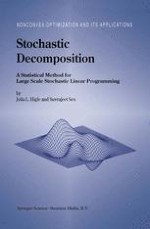Motivation Stochastic Linear Programming with recourse represents one of the more widely applicable models for incorporating uncertainty within in which the SLP optimization models. There are several arenas model is appropriate, and such models have found applications in air line yield management, capacity planning, electric power generation planning, financial planning, logistics, telecommunications network planning, and many more. In some of these applications, modelers represent uncertainty in terms of only a few seenarios and formulate a large scale linear program which is then solved using LP software. However, there are many applications, such as the telecommunications planning problem discussed in this book, where a handful of seenarios do not capture variability well enough to provide a reasonable model of the actual decision-making problem. Problems of this type easily exceed the capabilities of LP software by several orders of magnitude. Their solution requires the use of algorithmic methods that exploit the structure of the SLP model in a manner that will accommodate large scale applications.
